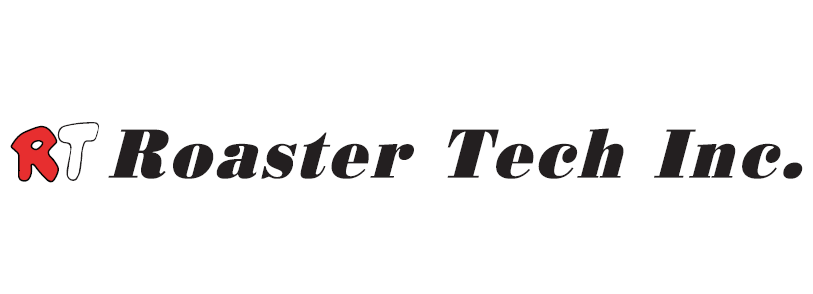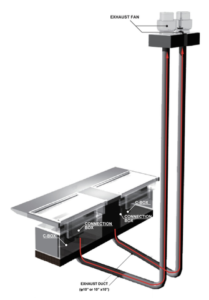Roaster Tech’s Downdraft System brings many benefits to Hibachi & Barbeque restaurants. While it lowers running costs such as electricity and cleaning, customers can enjoy the restaurant interior from the hoodless design. Discover how this system can improve your restaurant’s profitability to its best!
1, Go Green
Downdraft System is one of the solution for the global warming.
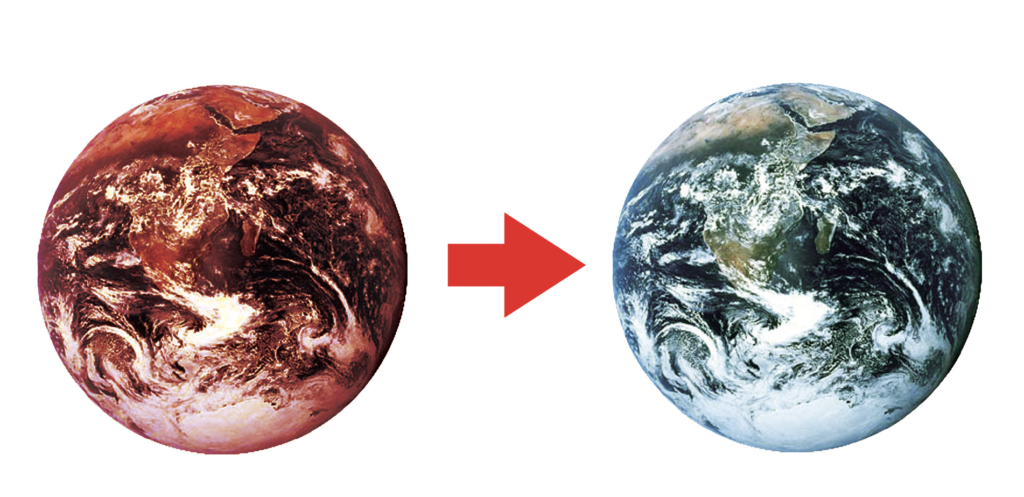
Global Warming is one of the most serious environmental concerns today.
Global warming may not seem personal, but saving energy can translate into a personal contribution to one’s community. We, at Roaster Tech, Inc., realized that saving energy and maintaining healthier environments for restaurant guests and chefs could be highly economical and thereby will benefits everyone in the long run.
2, Saving Energy
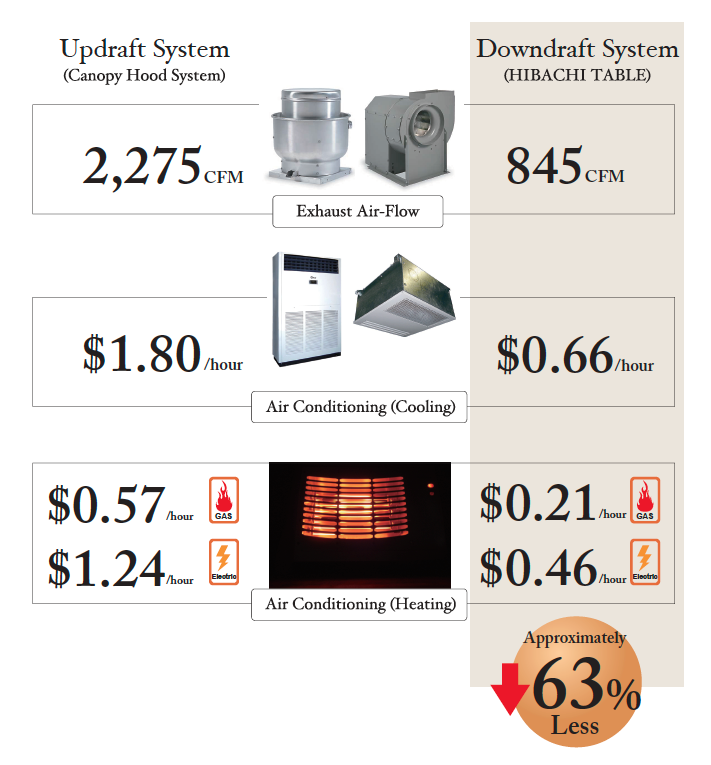
3, Human Health
Updraft System
(Canopy Hood System)

Escape into the environment is significant with updraft system resulting in facial heat and oily residues on hair and clothes. Customers and chefs breathe in oily, smokey air and oil drop from the above exhaust hood to customer’s head ,cloth, and food.
Downdraft System
(HIBACHI TABLE)

Safe and comfortable for both chefs and customers.
The Hibachi table chefs will no longer be in a cloud of smoke and will not have to endure breathing in oil. Also, because of the change in design of the tables, your chefs will not have to stand next to the steel cooking plate which you can imagine gets extremely hot. Most importantly, your customers will no longer be exposed to the oily smoke that often remains on their hair and clothes.
4, Human Health – 2
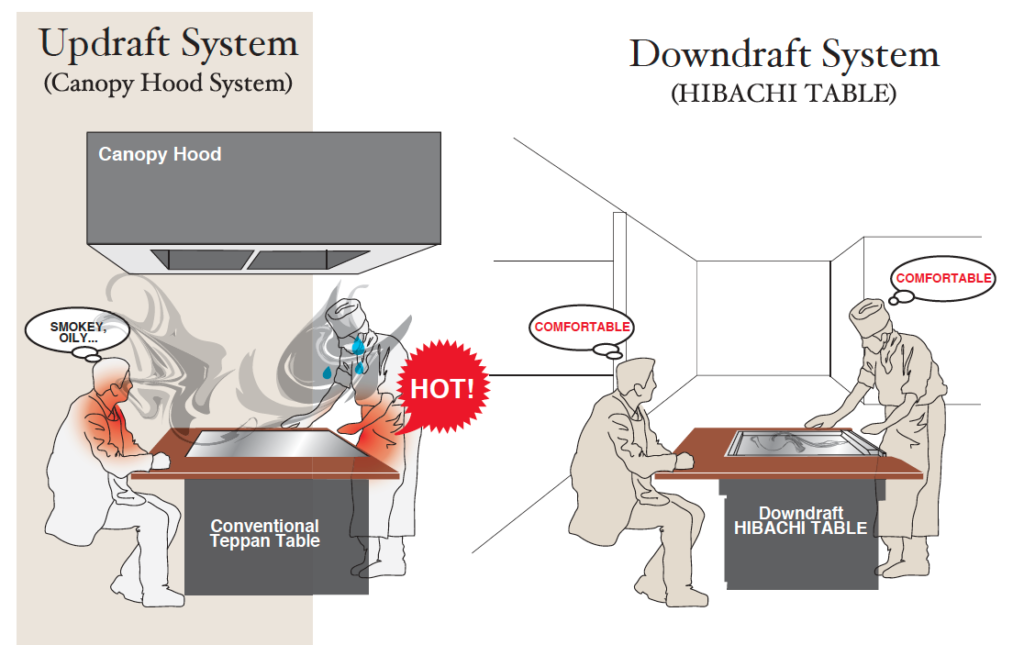
Indoor Temperature
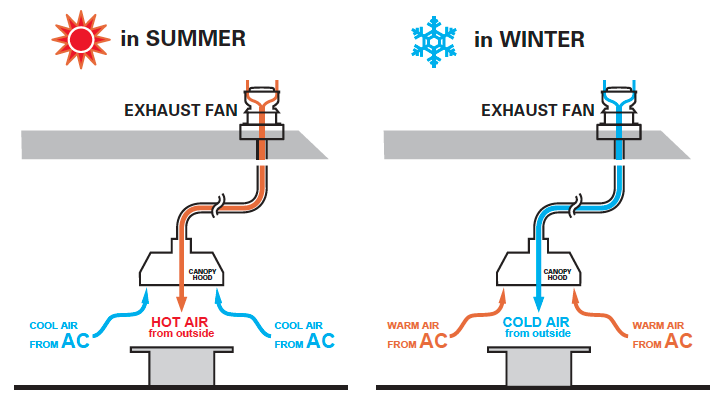
A comfortable air which adjusted by AC are sucked out to canopy hood for a usual updraft system, and the energy cost increases. Moreover, because cold/hot air can enter back into the room from the exhaust fan, it is very difficult to offer a comfortable space to the chef and the customer.
5, Cleaning
HIBACHI TABLE
Changing the oil filter within the table is made simple through the built-in access panel that allows you easy access to the oil filter for cleaning.
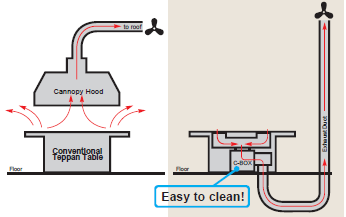
Escape into the environment is significant with updraft system, even those with large canopies, and needs frequent cleaning.
The Downdraft system nearly eliminates escapes of those noxious by products. Your furniture (chairs and tables) as well as your walls, ceiling, lights, etc. will not have to be constantly replaced/repainted and will not have any oily residue on them.
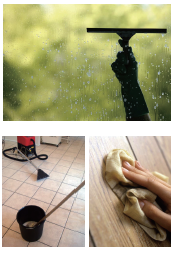
6, Interior Design
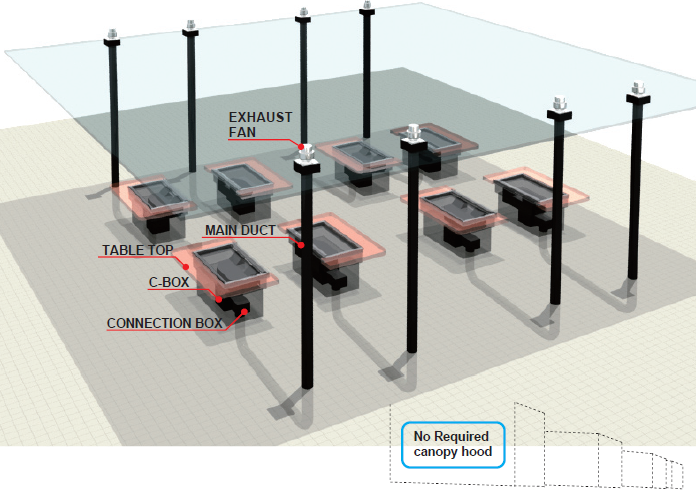
- Improved appearance and ambience
- Bulky obstructive canopy hood no longer needed.
- Unobstructive view as shown in 3-D graphics.
- Restriction-free design provides comfortable, pleasant dining atmosphere.
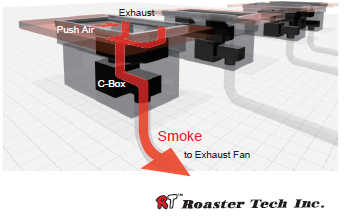
7, Data
Energy Use Comparison for Restaurants using Downdraft Roaster Tech Hibachi Tables as Compared to Using Conventional Overhead Exhaust Vented Hibachis
The basis of the comparison would be the dining room since that is where the hibachi units would be installed and have the biggest impact and that is where the guests/restaurant customers stay.
As part of good restaurant practice is the idea to keep the guest comfortable. For that you have to eliminate cooking odors and smoke and also maintain the room environment, (temperature, heating, cooling, air conditioning, and humidity) at comfortable levels so that the guests have a pleasant experience.
For the energy comparison we based the energy use on hibachi appliances of approximately the same size (approximately 5 foot long by 3 foot wide) and with the same firing input, 38,000 BTU/Hr. natural gas or propane fueled. One of the hibachi units is of the downdraft type the other is conventionally exhausted by use of overhead hoods.
| Features | OWNDRAFT SYTEM | OVERHEAT HOOD | Comments |
|---|---|---|---|
| Firing rate, natural gas. | 38,000 BTU/Hr | 38,000 BTU/Hr | |
| Cost to fuel hibachi for 1 hour at cost of $1.25 for 100 Cubic feet of gas. | $0.47 | $0.47 | Cost of fuel to operate is the same for each unit. |
| Required exhaust to capture all cooking odors, smoke.This air is mostly conditioned air taken from the dining room and air replacing it has to be either heated or cooled to provide a pleasant dining room. | 845 cfm of conditioned room air, (heated, cooled), as verified by agency tests. | Average of 2275 cfm of conditioned room air is required exhaust volume for overhead hoods. | Overhead hoods must be sized to extend beyond the appliance at least 6″ to 12” according to most local codes. Minimum hood length for sample unit is 6° to 7° long. By experience we have noted the exhaust volume needed for complete capture with and overhead hood is 300 to 400 cfm (cubic feet per minute) per foot of hood length. This calculation used 350 cfm and the shorter 6” hood length. If the larger hood and flow are used the value would be 2800 cfm. |
| AIR CONDITIONING Tons of air conditioning required to condition make up air entering room to replace exhausted air every hour. | 2.1 tons or 25,350 BTU/Hr 66 cents per hour for cooling. | 5.7 tons or 68,250 BTU Hr. or $1.80 per hour to cool the volume of incoming air to make up for exhaust. This is about $1.14 less in operation costs per hour per unit. | Overhead hood is 2.7 times per unit or 270% more expensive in cooling costs during high heat and humidity months. Calculation assumes that both type units are on full on rate for full hour. One ton of cooling is about 400 cfm. |
| HEATIG COSTS Heating load for building required to heat incoming make up air 15°F warmer during heating season. | 21 cents per hour for gas heat, 46 cents for electric heat. This amount is generally lower than the fuel cost to operate the downdraft unit. | 57 cents per hour for gas heat, 124 cents per hour for electric heat. This amount can be more than the actual fuel cost needed to operate the overhead exhausted hibachis. | Overhead hood is 2.7% times per unit or 270% more expensive in air heating costs during heating season. Calculation assumes that both type units are on full on rate for full hour. Fuel costs are based on $1.25 for 100,000 BTU of heat or 9 cents per Kw of electric power in Alabama during August 2009. |
Summary
The use of the downdraft hibachi tables though costing the same to operate for fuel as the
overhead vented units provide considerable savings since the units themselves pay back the user
in energy savings for the building air conditioning and heating loads which are considerably less
since less building make up air has to be conditioned.
For example, cooling cost at about $1.14 less per unit operating hour for each downdraft unit.
For eight hours a day operation, that equals $9.14 per unit daily savings in the target area of
Alabama.
Ten units would provide a potential savings in electric energy of up to 91.40 per day.
Even if these ten units operate for only 50% of the time, that would still be $45.60 in daily savings.
In one month that could equal $1360.00 electric utility savings.
The overhead hoods have some additional sanitation and food safety issues. Namely, cooking
vapors contain steam, CO2 and grease and as these products are drawn up to the exhaust hood
they can collect on the hood and condense out and then drip back on the customer.
Customers and cooks sitting and standing in the exhaust stream can also inhale these compounds,
whereas such exposure is considered detrimental by health officials.
Grease dripping back on the cooking surface creates other sanitation related problems bacteria
and dirt can be washed back onto food contact zones. This hazard does not exist with downdraft
hibachi units.
Any question?
Using our innovative new downdraft system, an overhead hood will no longer be necessary. The Unrestrictive design provides a comfortable and pleasant dining atmosphere! For any questions or concerns about our product, please do not hesitate to contact us at our office, or through the Inquiry Form on our website.
